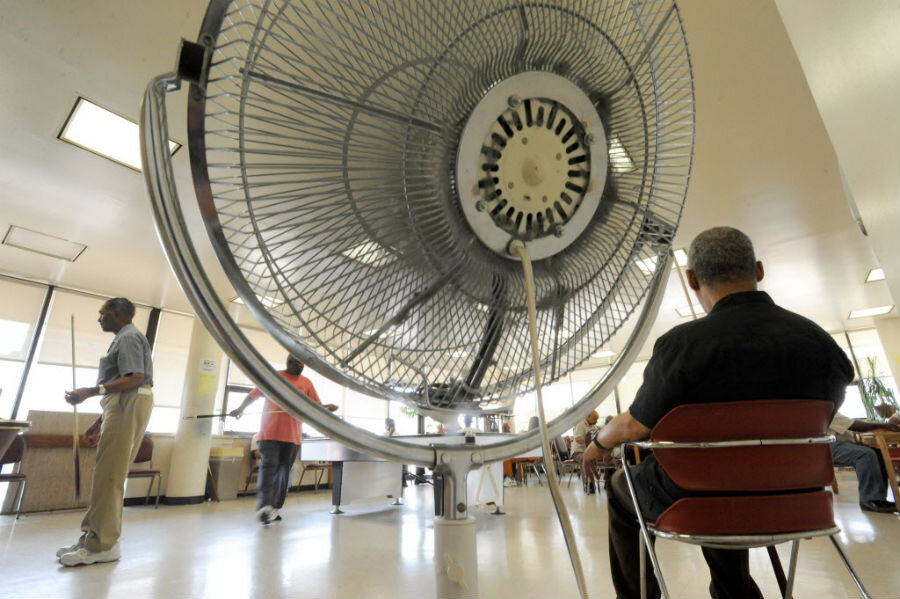Scientists take step toward revolutionary coolant ... using outer space?
Loading...
A team of scientists say they have demonstrated for the first time a way to harness the most ubiquitous coolant available, outer space, to chill structures on Earth's surface throughout the day, including hours of peak sunlight.
They have devised a Dagwood sandwich-like coating that reflects 97 percent of the sunlight striking it while serving as an express lane for infrared radiation – heat – welling up from below. Materials in the layers were selected, and the layers carefully arranged, to alter the wavelengths of upwelling infrared radiation so that they fall within a narrow band of wavelengths that pass unhindered through Earth's atmosphere.
In a rooftop test in mid-December 2013, the researchers found it kept its test enclosure nearly 9 degrees cooler than the air outside the enclosure.
Roughly 15 percent of the energy buildings use in the United States is expended on cooling, suggesting that if cost-effective passive approaches can be developed, they could reduce that consumption considerably. In the developing world, the approach has the potential to bring residential cooling to places where no cooling now exists and without a need for electricity, the researchers suggest.
The generic name for the approach is radiative cooling, explains Aaswath Raman, who led the effort along with Stanford colleague Shanhui Fan and is the lead author of a paper describing the results in Thursday's issue of the journal Nature.
Researchers have been exploring the general concept of radiative cooling since the 1960s and '70s, he says. The approach has been shown to work well at night – a phenomenon familiar to anyone who has stood outside on a cloudy winter's night and a clear one the next night and compared the temperatures.
In looking at the issue, "we were immediately struck by the fact that when it comes to cooling, demand for that obviously is greatest during the day. But no one had demonstrated radiative cooling under sunlight," Dr. Raman says.
He and his colleagues conduct research in optics and nanophotonics – designing materials at the scale of billionths of a meter, allowing the materials to manipulate light in unusual ways.
The team first set out its ideas in a paper last year in the journal Nano Letters. They modeled the kind of structure a coating would need to simultaneously reflect visible light back into space and allow infrared radiation to pass through the coating within the proper range of wavelengths to take advantage of the atmosphere's infrared "window" to space.
In the process, they modeled the potential benefit of passive heating during the day for a typical one-story home in Chicago or Orlando, Fla. If passive cooling occupied just 10 percent of the roof space, it could leave plenty of room for solar panels generating electricity while reducing the home's demand for air conditioning by 35 percent during the hottest part of the day.
The new paper described the team's work in turning the modeled cooling approach into a physical reality.
The team built its passive-radiator sandwich out of nine thin films variously made of silicon dioxide, hafnium dioxide, gold, and titanium, served up on a thin platter of silicon nearly eight inches across.
When they gave their approach the "roof test," the radiator cooled the interior of its enclosure. By contrast, a comparable enclosure containing a reflective patch of aluminum similar in size to the experimental device heated the air inside to some 36 degrees warmer than the outside air. A similar size wafer of silicon, painted black, boosted temperatures to more than 100 degrees F. higher than outside air temperatures, which hovered at around 40 degrees.
The groundbreaking approach to radiative daytime cooling is resonating with other researchers in the field of nanophotonics.
"I'm quite excited about what they have accomplished," says Marin Soljačić, a physicist at the Massachusetts Institute of Technology in Cambridge, whose research focuses on nanophotonics.
The work is exciting not only for its energy-saving potential at a time when the world is looking for ways to generate and consume energy in a more sustainable way, he says. It also is bringing the results of nanophotonic research out of the lab in a big way.
"In principle you can come up with an optimum nanostructure that does something spectacular – in theory," he says. The big challenge is to take that theoretical construct, build it, then reproduce it on human-size scales and cheaply enough so that it becomes embedded in the technology humans rely on.
"This is precisely what they have accomplished," he says, referring to the Stanford team's effort.








